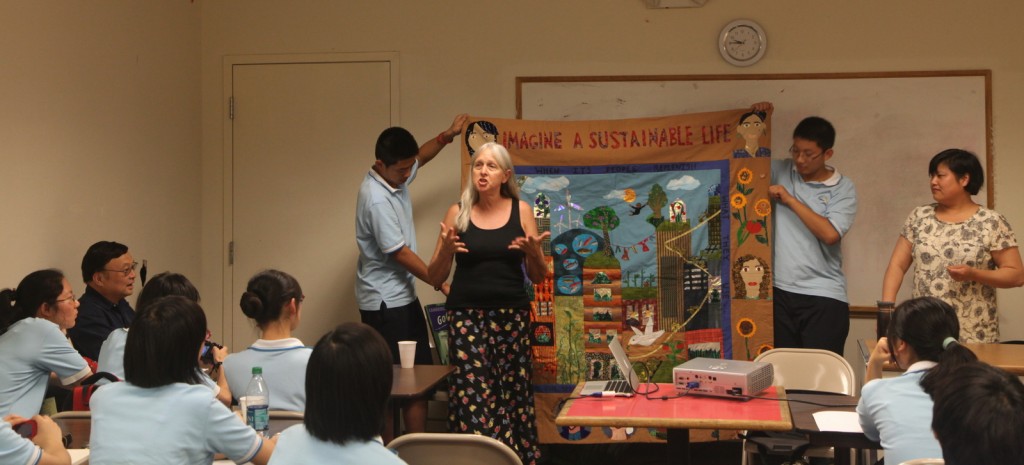By David Li, bostonese.com, translated by George Zeng, Cambridge Center for Chinese Culture
Waltham, Mass. – On the afternoon of July 17, a group of middle school students found themselves listening to an exceptionally unique lesson at Cambridge Center for Chinese Culture (CCCC) in Waltham. These 22 students from Beijing’s Experimental School Attached to Haidian Teachers Training College (ESHTTC) were visiting the United States on a special exchange program with the purpose of learning about modern American life and culture.

| The centerpiece of the lesson, a hand-made quilt representing the significance of the natural environment, aided the presenter, renowned journalist and editor Melissa Ludtke. She recounted the efforts of her daughter Maya and eight other friends in promoting environment awareness.
Lutdke, a graduate of the Wellesley College Class of 1973, had previously been an acclaimed staff member at some of America’s top magazines, including Sports Illustrated and Times, and had become one of America’s premier female sports journalists. Since 1992 she has been a fellow at Harvard University’s Nieman Foundation. Throughout her life she has dedicated significant effort and time for helping the poor and advocating for environmental protection. |
Ludtke began her presentation with an introduction to her daughter, Maya, whom Ludtke had adopted from China. At the young age of nine, Maya, now a student at Dr. Martin Luther King, Jr. School in Cambridge, established “Roots and Shoots,” a grassroots environmental program whose initial efforts included improvement of the school’s recycling efforts.
As the program grew, Maya and her eight friends created the quilt which Ludtke had brought for the presentation. The quilt presented a better future in which humans would live in harmony with the environment; some ideas depicted on the quilt included rooftop gardens, solar panels, sun-dried clothes, and multiple-level waste treatment. A dove at the center of the quilt represented the hopes of these nine children for world peace through environmental protection.
The bottom of the quilt included many famous figures of the environmental movement, one of who was Africa’s first female Nobel Peace Prize recipient, Kenya’s Wangari Maathai. Maathai was a renowned advocate for planting trees to protect the African environment—starting in 1977 with the Green Belt Movement. The movement succeeded in planting 30 million trees in 30 years, an accomplishment for which she was awarded the 2004 Nobel Peace Prize. Maathai passed away in 2011.
| According to Ludkte, Maya and her friends plan to donate the quilt to the city of Cambridge so that the quilt and its message may be displayed in schools and libraries. In addition, Ludtke noted that “Roots and Shoots” plans on “creating a website through which others may borrow the quilt in aiding their own environmental protection efforts, so that the message of the quilt can continue to be spread among the children of the world, including our friends from Beijing.” |
Afterwards, Ludtke answered questions for the Beijing students and gave advice as to how they could lead environmental efforts in their own school. Mr. Humin Ji, the chairman of the board of CCCC, along with Ms. Kai Tao, the principal of CCCC, expressed their gratitude and appreciation to Ms. Ludtke for the lesson.
Ms. Zhou Xiaohong, a supervising teacher from ESHTTC who accompanied the students on their visit, wrapped up by stating that “we are deeply moved by the quilt and by your efforts to protect the environment. We hope that the next time we visit America, we are able to report what progress we will have made in Beijing to protect the environment.”
Located at 411 Waverley Oaks Road, Building #2, Waltham, the Cambridge Center for Chinese Culture is a non-profit organization registered in Massachusetts, by Chinese scholars. It aims at promoting Chinese culture, advance the status of Chinese-Americans, and promote US-China relations through Chinese language education, publication, and cultural exchange. Its website is bostoncccc.org.